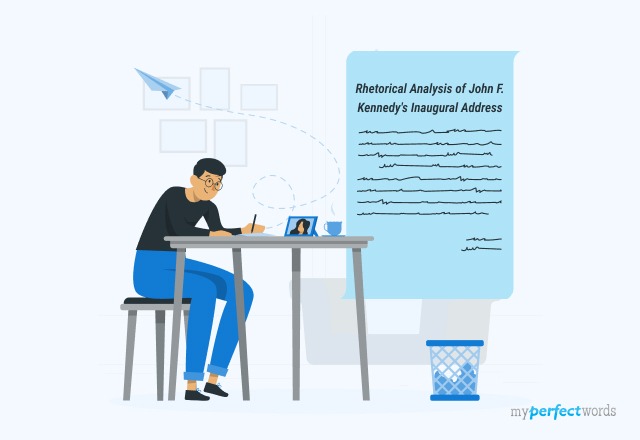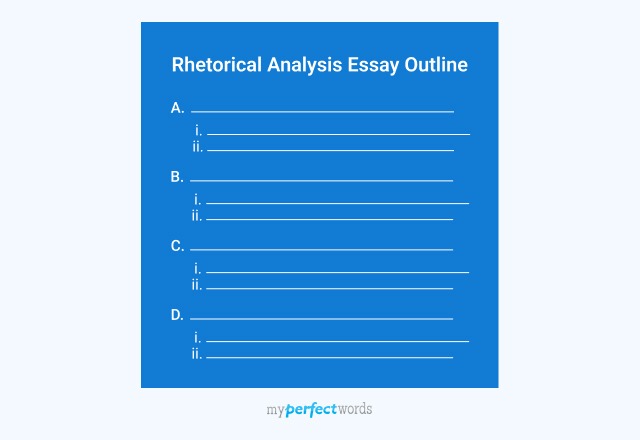Good Rhetorical Analysis Essay Example
The step-by-step writing process of a rhetorical analysis essay is far more complicated than ordinary academic essays. This essay type critically analyzes the rhetorical means used to persuade the audience and their efficiency.
The example provided below is the best rhetorical analysis essay example:
In this essay type, the author uses rhetorical approaches such as ethos, pathos, and logos. These approaches are then studied and analyzed deeply by the essay writers to weigh their effectiveness in delivering the message.
Let’s take a look at the following example to get a better idea;
Title: Analyzing the Rhetoric of John F. Kennedy's Inaugural Address Introduction: Rhetoric is a powerful tool leaders use to persuade and inspire their audiences. One of the most iconic speeches in American history is John F. Kennedy's Inaugural Address, delivered on January 20, 1961. In this rhetorical analysis essay, we will dissect Kennedy's speech to understand how he effectively employed rhetorical techniques to convey his vision for the United States and its role in the world. By examining Kennedy's use of ethos, pathos, and logos, as well as his adept use of rhetorical devices, we can gain insight into the impact of his words on the American people and the world at large. Body: Ethos: Establishing Credibility John F. Kennedy, as the newly elected President of the United States, begins his address by establishing his credibility (ethos) through references to the Founding Fathers and the Constitution. He aligns himself with the principles of the nation's founders, positioning himself as a guardian of American values. By doing so, he inspires confidence in his leadership and fosters a sense of unity among his diverse audience. Pathos: Evoking Emotion Throughout his address, Kennedy masterfully employs emotional appeals (pathos) to engage and connect with his audience. He speaks of the "long twilight struggle" and the "bond that spans the seas," invoking a sense of shared responsibility and destiny among Americans. His call to "ask not what your country can do for you – ask what you can do for your country" resonates deeply, stirring feelings of patriotism and duty. Kennedy's use of emotionally charged phrases fosters a sense of national purpose. Logos: Using Logic and Reasoning Kennedy integrated logical arguments (logos) into his speech by addressing the global challenges of the Cold War era. He speaks of the need to "avoid the disaster of a nuclear war" and emphasizes the importance of diplomacy and cooperation with other nations. By presenting these arguments, he appeals to the audience's sense of reason and pragmatism, outlining a clear and rational path forward for the nation. Rhetorical Devices: Amplifying Impact Kennedy employs several rhetorical devices to amplify the impact of his address. Anaphora, the repetition of the phrase "Let both sides" in the context of nuclear disarmament, emphasizes the urgency of the situation and the need for cooperation. Antithesis, as seen in "We shall pay any price, bear any burden," creates a stark contrast that underscores the sacrifices required for freedom. These rhetorical devices enhance the overall persuasiveness and memorability of his speech. Conclusion: John F. Kennedy's Inaugural Address is a testament to the power of rhetoric in shaping public opinion and inspiring action. By skillfully weaving ethos, pathos, and logos into his speech and using rhetorical devices to amplify his message, Kennedy effectively communicated his vision for America's role in the world. His call for unity, service, and global cooperation resonated with the American people and left an enduring impact. As we analyze his rhetoric, we are reminded of the enduring relevance of persuasive communication in leadership and the ability of a well-crafted speech to mobilize a nation toward a common goal. Kennedy's inaugural address serves as a timeless example of the art of persuasion at its finest. |
Want an essay written like this example? Our analytical essay writing service can create an roginal, top-quality essay for you.
The outline and structure of a rhetorical analysis essay are important.
According to the essay outline, the essay is divided into three sections:
- Introduction
- Main body
- Ethos
- Pathos
- Logos
- Conclusion
A rhetorical analysis essay outline follows a traditional essay outline. Here’s how each part is typically written:
Rhetorical Analysis Introduction Example
An introduction for a rhetorical essay is drafted by:
- Stating an opening sentence known as the hook. This catchy sentence is prepared to grab the audience’s attention to the paper.
- After the opening sentence, the background information of the author and the original text are provided.
For example, a rhetorical analysis essay written by Lee Jennings on“The Right Stuff” by David Suzuki. Lee started the essay by providing the introduction in the following way:
David Suzuki’s “The Right Stuff” features a gracious, entertaining, and informative style. We associate with this well-known host of The Nature of Things. He begins with the interesting speculation from the book Is There Life After High School? that “impressions formed in high school are more vivid and indelible than those formed at any other time in life. |
Analysis of the Example:
- Suzuki stresses the importance of high school education. He prepares his readers for a proposal to make that education as valuable as possible.
- A rhetorical analysis can show how successful Suzuki was in using logos, pathos, and ethos. He had a strong ethos because of his reputation.
- He also used pathos to appeal to parents and educators. However, his use of logos could have been more successful.
- Here Jennings stated the background information about the text and highlighted the rhetorical techniques used and their effectiveness.
Thesis Statement Example for Rhetorical Analysis Essay
A thesis statement of a rhetorical analysis essay is the writer’s stance on the original text. It is the argument that a writer holds and proves it using the evidence from the original text.
A thesis statement for a rhetorical essay is written by analyzing the following elements of the original text:
- Diction - It refers to the author’s choice of words and the tone
- Imagery - The visual descriptive language that the author used in the content.
- Simile - The comparison of things and ideas
In Jennings's analysis of “The Right Stuff,” the thesis statement was:
"Suzuki has strong beliefs, but his argument is not convincing because it is not supported by evidence." |
Rhetorical Analysis Body Paragraph Example
In the body paragraphs of your rhetorical analysis essay, you dissect the author's work. Each body paragraph opens with a topic sentence that shows the main point of that paragraph.
This is where you present the main analysis of their rhetorical techniques, and provide evidence to support your analysis.
Let's look at an example that analyzes the use of ethos in David Suzuki's essay:
Body Paragraph - Analyzing Ethos David Suzuki, a well-known host of "The Nature of Things" and a respected scientist in the field of environmentalism, expertly employs ethos in his essay, "The Right Stuff." Suzuki's ethos is immediately established through his impressive background and extensive experience in the field. As a scientist, he has dedicated his career to understanding and addressing environmental issues, which lends him considerable credibility on the subject. Moreover, Suzuki's role as a popular television host further solidifies his ethos. His presence in the media has made him a recognizable and influential figure, particularly among those interested in environmental matters. When Suzuki speaks, his audience often associates his words with authority and expertise in the field. Throughout his essay, Suzuki utilizes his ethos to build trust with his readers. He references his own experiences and interactions, stating, "In a lifetime of lecturing, I've discovered that people have strong opinions on environmental issues." By sharing his encounters, Suzuki humanizes himself, making his readers more inclined to trust his perspective. Suzuki's ethos is a pivotal component of his argument. It strengthens his credibility and positions him as a reliable source of information on environmental issues. As a result, his call for greater environmental awareness and action carries significant weight and persuasiveness. |
Rhetorical Analysis Conclusion Example
All the body paragraphs lead the audience towards the essay’s conclusion.
Here is the conclusion for rhetorical analysis essay example by Jennings:
"The major question overlooked by Suzuki’s essay—one of logistics-- is how can schools, understaffed and overstressed, add the difficult subject of sex education to their curriculum. Admittedly, David Suzuki wrote his essay at a time when education budgets were in better shape than they are today. And he certainly makes an excellent point that educators should respect their students and appeal to their interests. Nevertheless, his argument for sex education in schools needs further thinking. Suzuki has a strong ethos and uses persuasive pathos well in this argument. However, he needs to use more logos to make his point clear. He can only hope to get people's attention. It is up to them whether or not they want to use his ideas in the schools." |
Analysis of the Example:
In the conclusion section, Jennings summarized the major points and restated the thesis statement to prove them.
Rhetorical Analysis Essay Examples for Students
Writing a rhetorical analysis for AP Language and Composition courses can be challenging. Here are some AP English language rhetorical analysis essay examples:
Here are a few more rhetorical analysis essay examples pdfs to help students:
Writing a Visual Rhetorical Analysis Essay with Example
The visual rhetorical analysis essay determines how pictures and images communicate messages and persuade the audience.
Usually, visual rhetorical analysis papers are written for advertisements. This is because they use strong images to convince the audience to behave in a certain way.
To draft a perfect visual rhetorical analysis essay, follow the tips below:
- Analyze the advertisement deeply and note every minor detail.
- Notice objects and colors used in the image to gather every detail.
- Determine the importance of the colors and objects and analyze why the advertiser chose the particular picture.
- See what you feel about the image.
- Consider the objective of the image. Identify the message that the image is portraying.
- Identify the targeted audience and how they respond to the picture.
An example is provided below to give students a better idea of the concept.
Rhetorical Analysis Essay Writing Tips
Follow the tips provided below to make your rhetorical writing compelling.
- Choose an engaging topic for your essay. The rhetorical analysis essay topic should be engaging to grab the reader’s attention.
- Thoroughly read the original text.
- Identify the SOAPSTone. From the text, determine the speaker, occasions, audience, purpose, subject, and tone.
- Develop a thesis statement to state your claim over the text.
- Draft a rhetorical analysis essay outline.
- Write an engaging essay introduction by giving a hook statement and background information. At the end of the introductory paragraph, state the thesis statement.
- The body paragraphs of the rhetorical essay should have a topic sentence. Also, in the paragraph, a thorough analysis should be presented.
- For writing a satisfactory rhetorical essay conclusion, restate the thesis statement and summarize the main points.
- Proofread your essay to check for mistakes in the content. Make your edits before submitting the draft.
All in all,
Following the tips and the correct writing procedure will guarantee success in your academics.
We’ve provided plenty of examples of a rhetorical analysis essay. But if you’re still struggling to draft a great rhetorical analysis essay, it’s a good idea to seek professional help.
MyPerfectWords.com can assist with all your academic assignments. Get analytical essay assistance if you’re confused about your writing assignments or struggling to meet a deadline.
Feel free to place your 'Just do my essay' request and hire our serivces today at the most reasonable prices.





